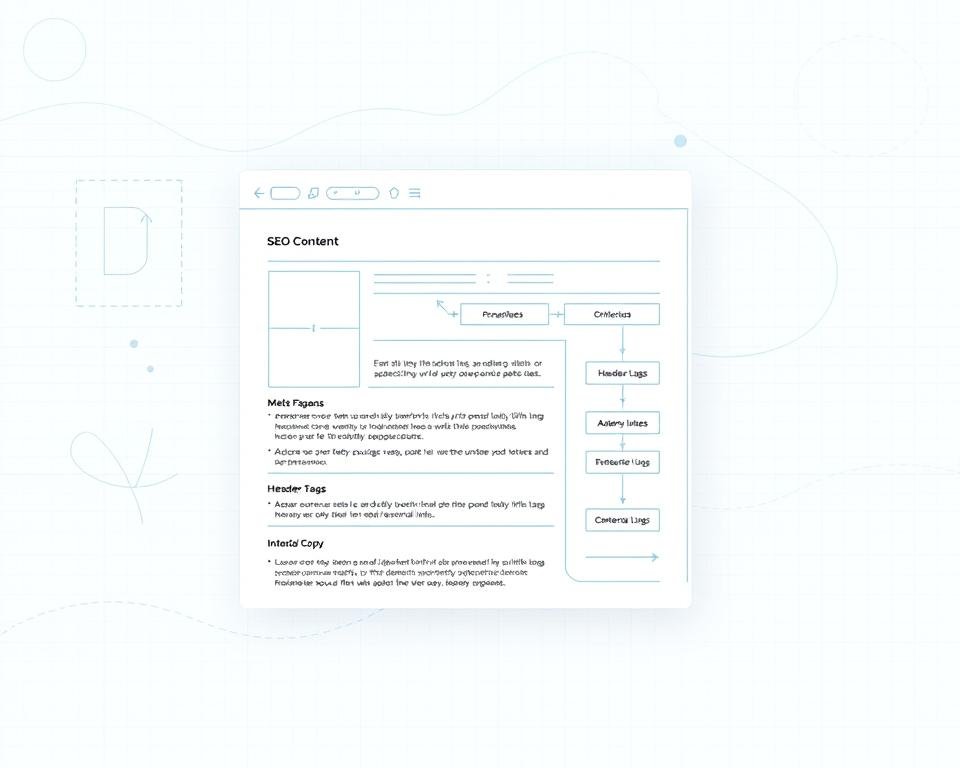Knowing what your competitors do in SEO is key today. By looking at their moves, you can get ahead and improve your own SEO game.
Seeing what your rivals do well and not so well helps you tweak your plan. You’ll look at their keywords, content, and how they get links.
This way, you spot chances to beat them. It’s vital for making a strong SEO plan that works.
Key Takeaways
- Analyzing competitors’ SEO strategies reveals their strengths and weaknesses.
- Gaining a competitive advantage requires understanding competitors’ keyword choices.
- Refining your SEO approach involves examining competitors’ content quality.
- Link building techniques used by competitors can inform your own strategy.
- Identifying market gaps is key to outranking competitors.
Understand the Importance of SEO Competitor Analysis
Knowing what your competitors do with SEO can make your strategy better. In today’s digital world, it’s not just about using SEO. You need to know what works and what doesn’t in your field.
What is SEO Competitor Analysis?
SEO competitor analysis is about looking at what your competitors do to rank high in search engines. It shows you where your SEO might be lacking and how to get better. By seeing what your competitors do well and not so well, you can make your SEO stronger.
This process looks at keywords, content, backlinks, and technical SEO. Each part gives clues on how search engines see your competitors. This helps you see how to make your site more visible.
Why Monitor Your Competitors?
Watching your competitors is key for several reasons. It keeps you up-to-date with the latest SEO trends. By watching your competitors, you can find new chances and threats to your online presence.
Also, it lets you compare your SEO to your competitors. This shows where you need to get better. It guides your SEO efforts in the right direction.
Key Benefits of Competitor Analysis:
- Identify gaps in your SEO strategy
- Uncover new opportunities for improvement
- Stay ahead of the competition by adapting to the latest SEO trends
| Competitor Analysis Aspect | Description | Benefit |
|---|---|---|
| Keyword Analysis | Examining the keywords your competitors are targeting | Identify new keyword opportunities |
| Content Quality | Assessing the quality and relevance of your competitors’ content | Improve your content strategy |
| Backlink Profile | Analyzing the backlinks pointing to your competitors’ sites | Enhance your link building strategy |
Identify Your Main Competitors
Before you can outmaneuver your competitors, you need to know who they are. Knowing your main competitors is key to a good SEO strategy. You must understand your industry and find the top players.
First, you need to know the different types of competitors. This helps you plan your strategy better.
Direct Competitors vs. Indirect Competitors
Direct competitors offer similar products or services to the same audience. They are your direct rivals. Indirect competitors may not be exact matches but can affect your business by providing alternatives.
In e-commerce, a direct competitor of an online shoe store is another online shoe store. An indirect competitor could be a physical shoe store or an online marketplace with shoes and more.
Tools for Identifying Competitors
Many SEO tools can help find your competitors. Some top tools are:
- Ahrefs: Gives insights into competitors’ backlinks, content, and keywords.
- SEMrush: Analyzes competitors’ traffic sources and keyword gaps.
- Moz: Helps spot competitors and check their domain authority and keyword rankings.
These tools let you do deep keyword research. You learn what keywords your competitors target. This info is great for improving your SEO strategy and finding market gaps.
Understanding your competitors and their strategies helps you make better SEO choices. It’s not just about knowing who they are. You also need to analyze their strengths and weaknesses to get ahead.
Analyze Competitors’ Keywords
Knowing what keywords your competitors use can make your SEO better. It helps you find what you’re missing and how to beat them. This way, you can rank higher in search results.
Tools to Discover Target Keywords
Many tools can show you what keywords your competitors aim for. Some top ones are:
- SEMrush: Gives deep insights into competitors’ keywords and shows what you’re missing.
- Ahrefs: Does a full keyword analysis and looks at competitors.
- Moz Keyword Explorer: Finds good keywords and shows how hard they are to rank for.
These tools give you key insights into your competitors’ content strategy. They help you make a better SEO plan.
Understanding Keyword Difficulty
Keyword difficulty shows how hard it is to rank for a keyword. Knowing this is key for a good SEO plan. Here’s what affects keyword difficulty:
- Competition: How many sites are fighting for the same keyword.
- Authority: The ranking sites’ authority.
- Relevance: How well the keyword fits your website’s content.
By looking at these, you can see how hard it is to rank for certain keywords. Then, you can tweak your backlink analysis and content plan.
To make your keyword strategy even better, try these tips:
- Go for long-tail keywords that are easier to rank for.
- Use keyword research tools to find good keywords.
- Look at your competitors’ keyword strategies to find gaps.
Evaluate On-Page SEO Strategies
To stay ahead in SEO, it’s key to check your competitors’ on-page SEO tactics. On-page SEO means making each web page better for search engines. Knowing how competitors do this can help you boost your own strategy.
Title Tags and Meta Descriptions
Title tags and meta descriptions are very important for on-page SEO. They tell search engines about your webpage’s content and structure. A good title tag should be clear and include important keywords. A great meta description should make users want to click on your link.
| Element | Best Practice | Competitor Example |
|---|---|---|
| Title Tag | Include target keywords, be descriptive | “SEO Strategies for Small Businesses” |
| Meta Description | Entice users to click, include target keywords | “Discover effective SEO strategies to boost your small business’s online presence.” |
Content Quality and Structure
Good content is key for on-page SEO. Use header tags to organize your content. Include important keywords naturally. Make sure your content is both informative and fun to read. A clear content structure makes it easier to read and understand.

Image Optimization
Optimizing images is also very important. Use clear file names, alt tags, and compress images to speed up your site. Optimized images can help your site show up in image searches and make it better for users.
- Use descriptive file names that include target keywords.
- Write compelling alt tags that describe the image.
- Compress images to reduce file size and improve page load times.
By looking at and improving these on-page SEO strategies, you can get your site to rank higher. This will bring more visitors to your site.
Investigate Backlink Profiles
Looking into your competitors’ backlink profiles can show their SEO strengths and weaknesses. Backlinks are links from other sites to your competitor’s site. They are key to their search engine ranking.
Significance of Backlinks in SEO
Backlinks are very important for SEO. They show search engines that a site is trustworthy and has good content. The quality and number of backlinks can greatly affect a site’s ranking.
High-quality backlinks from important sites can make a site more credible. But low-quality backlinks can harm it.
Tools for Backlink Analysis
To check your competitors’ backlink profiles, use tools like Ahrefs, SEMrush, and Moz. These tools give you info on the number and quality of backlinks. They also show the anchor text used.
- Ahrefs: Offers a detailed backlink analysis, including the number and quality of backlinks.
- SEMrush: Has a backlink analytics tool that helps you understand your competitors’ backlink profiles.
- Moz: Provides a backlink analysis tool that gives insights into the quality and number of backlinks.
By looking at your competitors’ backlink profiles, you can find ways to get high-quality backlinks for your site. This can help improve your SEO strategy.
Explore Competitors’ Content Marketing
Looking at your competitors’ content marketing can show you what’s missing in your own plan. You can see what content they make and how often. This helps you make a better content strategy.
Types of Content Strategies Used
Competitors use many ways to draw in and keep their audience. They might:
- Write blog posts about specific topics
- Make infographics with important stats
- Post videos to explain tough ideas
- Do podcasts with industry pros
- Share e-books with detailed guides
By checking out your competitors’ content, you can see what works for your audience. Then, you can change your strategy to fit better.

Frequency and Consistency of Content
How often and regularly you post content matters a lot. Posting the same way every time keeps your audience interested and helps your SEO.
| Content Type | Frequency | Impact on SEO |
|---|---|---|
| Blog Posts | Weekly | Improves keyword rankings |
| Social Media Posts | Daily | Boosts engagement and brand visibility |
| Videos | Monthly | Enhances audience engagement and watch time |
Looking at how often your competitors post can help you plan a good strategy. It should be effective and easy to keep up with.
Review Social Media Presence
To get ahead, check out your rivals’ social media moves. A strong online presence boosts your search ranking. It makes you more visible online and brings more visitors to your site.
Social Signals and Their Impact on SEO
Social signals like likes, shares, and comments matter a lot in SEO. They don’t directly change your ranking, but they help. They bring more people to your stuff and make it more seen.
Key benefits of social signals include:
- Increased content visibility
- Improved brand awareness
- Enhanced credibility
- More traffic to your website
Analyzing Engagement and Content Sharing
See how your competitors’ content does on social media. This tells you a lot about their strategy. Find out what makes their content hit it off.
| Metric | Description | Importance |
|---|---|---|
| Engagement Rate | Measures how actively your audience interacts with your content | High |
| Content Sharing | Indicates how often your content is shared on social media | High |
| Follower Growth | Tracks the rate at which your social media following is growing | Medium |
Get these metrics and see how they help your rivals. Use this info to make your social media better. This will help your ranking and give you an edge.
Utilize SEO Tools for In-Depth Analysis
To get ahead, using the right SEO tools is key. Today, knowing what your competitors do online is vital. It helps you make a strong plan.
Popular SEO Analysis Tools
Many SEO tools can help you see what your competitors do. Some top ones are:
- Ahrefs
- SEMrush
- Moz
- Google Search Console
These tools have many features. They help with keyword research and backlink analysis. This gives you insights into your competitors’ online moves.
How to Use Them Effectively
To make the most of these tools, knowing how to use them is important. Here are some tips:
Identify the right keywordsusing tools like Ahrefs or SEMrush. This helps you see what keywords your competitors use.
| Tool | Feature | Benefit |
|---|---|---|
| Ahrefs | Keyword Research | Identify relevant keywords |
| SEMrush | Competitor Analysis | Analyze competitors’ strategies |
| Moz | Backlink Analysis | Understand backlink profiles |
By using these tools, you can learn a lot about your competitors. This helps you make a better plan for your online strategy.
Understand Technical SEO Strategies
Learning about your competitors’ SEO can help you improve your site. Technical SEO deals with how search engines see and rank your site.
Site Speed and Performance Metrics
Site speed is key for both users and search engines. A slow site can hurt your rankings and sales. Use tools like Google PageSpeed Insights or GTmetrix to check your site’s speed.
Key performance metrics to monitor include:
- First Contentful Paint (FCP)
- Speed Index
- Total Blocking Time
- Largest Contentful Paint (LCP)
Mobile Optimization Techniques
Most searches are now on mobile. So, making your site mobile-friendly is a must. Look at your competitors’ mobile sites for ideas.
Key mobile optimization techniques include:
- Responsive web design to adapt to different screen sizes
- Mobile-friendly navigation and content formatting
- Optimizing images and videos for faster load times on mobile
Studying your competitors’ mobile sites can show you what to improve on your own.
Keep an Eye on Competitor Updates
Watching your competitors helps you get better at SEO. The world of search engine optimization is always changing. You need to stay alert to keep up.
Tracking your competitors lets you find weak spots in your plan. You can grab chances before they’re gone. This way, you can make your SEO plan stronger and more competitive.
Setting Up Alerts for Competitor Changes
To know about your competitors’ updates, setting alerts is key. Google Alerts can tell you when they change their site or content.
Here’s how to set up good alerts:
- Find the right keywords for your competitors
- Set alerts for their website changes
- Watch their social media and content
How to Act on New Insights
After getting insights from your competitors, you must act wisely. Look at the info to see how it affects your SEO plan.
Here are some actions to consider:
- Change your keyword strategy based on what your competitors do
- Make your website better to match your competitors’ new features
- Update your content marketing to stay ahead
By always watching your competitors and using new info, you can stay on top in SEO.
Develop Your Own SEO Strategy
Now that you’ve looked at your competitors’ SEO plans, it’s time to make your own. Knowing their good and bad points helps you make a plan that beats them.
Putting Insights into Action
Use what you learned from your competitors to shape your SEO plan. Find areas where you can do better and outdo them. This will improve your keywords, content, and links.
Continuous Monitoring and Adaptation
SEO keeps changing, and so should your plan. Use tools like Google Analytics to check how you’re doing. Change your strategy when needed to keep up with new trends and rules.
By doing these steps, you can make a strong SEO plan. It will help you get better results and stay ahead of others.
